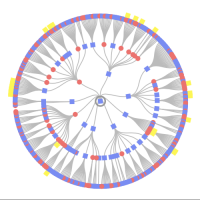Living People Marked As Deceased
I have become very concerned about the numbers of people who are still living being marked as deceased. I have an uncle who died on December 21, 2022, at the age of 90, and when I went in to add his death information I found another record of him where he had been marked as deceased earlier in the year.
A couple of years ago I experienced something similar with my husband's aunt. When I added her husband's death information I discovered that she had been marked as deceased even though she was very much alive (and still is).
In the past year I have come across about half a dozen other people who are marked as deceased but who appear to be alive. I've done what I can to get that designation corrected but have not always been able to.
I have a suggestion as to how this problem could possibly be rectified. If a person was born in the last 110 years I feel their complete death date, and possibly place of death, should have to be supplied as proof of their death. The way it is now they can be marked as deceased just by clicking on deceased. We are supposed to state why we believe they are deceased but in some cases there is no reason given. In my uncle's case that field had just been marked "unknown".
Comments
-
@MBuck Your suggestion has been submitted to the appropriate department. Thank you for sharng your idea!
1 -
In some countries privacy laws are much stricter than the in the USA. In the Netherlands – where I am from – for instance such records are only released to the public once all people mentioned on the record have been dead for some years. And so I too have accidentally marked people dead while they weren't, because I assumed that all records available only contain people that have been dead for some time already.
And so I received messages from upset people also. It shocked them, but it also shocked me. But was able to settle them as I explained what had happened. And so I also figured out that the privacy laws in some countries are either broken, or are different. However, there must be a reason for a living person in the big tree not being visible for the public.
The other thing about people still being alive is, that if you mark them alive, that you are the only one who can see them. And some of those people are not close enough to me, and it not making any sense if I'm the only one to see them.
These days, I just mention it in the details box when I doubt, and suggest people who may bump into such files, to mark them alive themselves, as this seems to be a way, to 'hand the file over' to the person who these still living people are valuable to.
0 -
The convention is quite straightforward. We should add all individuals born less than 110 years ago with a Living status, unless we have evidence of their death.
You acknowledge your understanding about this being connected to privacy laws, so you must not be concerned about the IDs you are adding not being visible to other users. Please do not expect others to change the status (from Deceased to Living) as the onus is on the person making the original input to enter this correctly.
0 -
@s10297588641, revealing the sexes and number of children in a family is a breach of privacy. The fact that Ancestry and other sites do it doesn't change this fact.
1 -
Julia is correct. Showing that a living person exists is a violation of the privacy rule. For example, if I got divorced, I wouldn't want another user seeing I remarried, had kids...
1 -
Showing that a living person exists is a violation of the privacy rule.
So this thread - someone marking a living person deceased - is also a violation. As well as any Sources which reveal living persons - which means public records will not be found on FamilySearch? I think there are some collections which do reveal living persons...
Relations at Rootstech, Family Groups, Memories - all should have documented consent/ permission fields (some do but later are time limited/removed) that stay with the app/document. Any collaboration or contact option has account permissions settings ...
the options for revealing or "show my relationship" to limited persons/Family Groups needs some improvement - currently the permission/consent is "all or nothing" - either no collaborative revealing or complete/public revealing (strategically for the platform this makes sense but allows no fine-tuned/limited group option for the account holder to choose). FamilySearch obviously recognizes this weakness - as: https://www.familysearch.org/en/blog/whats-new-in-familysearch-2023
New Family Tree Features section explains these features will be implemented this year.
Such features will work for living persons with a FamilySearch account - but there still needs to be the permissions/consent option - that stays attached to document, Memory or profile for those possibly without an account/not participating.
1 -
marked as deceased but who appear to be alive. I've done what I can to get that designation corrected but have not always been able to.
The procedure is quite simple: on the profile details page, change Deceased to Living and when prompted give as a reason something like "known to be living" or "cannot confirm death". You will get an email stating the result.
0 -
There are many official records and private company records that have living persons. For instance the US 1950 census was released this year by NARA. So anyone over 73 may still be alive in those records. In the end it is the user that adds the person to FamilyTree that is responsible. If you run across a deceased Person you know is alive then report that. Those are usually handled by support very quickly.
0 -
Showing that a living person exists isn't necessarily a privacy breach by itself. Showing that he exists _in a particular family_ can be.
The 1950 census by itself is borderline in terms of privacy of living people: the likelihood of someone still living at that same address with all of those same people is effectively zero (especially since we've added Zip codes since then), but when it's attached to Family Tree, it can reveal the answer to the banking industry's still-favorite security question of the mother's maiden name.
0 -
In England & Wales there are very confusing messages regarding privacy. For example, on the issue of the mother's maiden name, the GRO website (government agency) only provides the mother's surname for birth registrations that took place up to 100 years ago. However, these are provided on the FreeBMD site for births up to the 1990s. So whilst the government here seems to acknowledge the right to some degree of privacy for the living on its own website, it does not enforce non-publication of these details elsewhere.
I appreciate FamilySearch has to attempt to address privacy laws relating to all countries where its website is openly available, but it seems rather too easy to add not just individuals who are still alive, but to add them in family groups, too. In this respect, the (rather badly supervised) "Volunteer Project(s)" continues be responsible for adding unchecked data to the FamilySearch database. Meanwhile, as Joe acknowledges, the US 1950 census has led to many more living persons having their profiles (and those their living family members) openly displayed on Family Tree (by being carelessly added with a Deceased status) - by both individuals and FamilySearch sanctioned projects. As Joe suggests, we can easily get the status changed (to Living) for examples we encounter, but there must be many thousands of records that have been added for individuals / familes who are still very much alive, but have nobody to check-out their profiles.
I acknowledge the difficulty of the issue, especially when it comes to FamilySearch's administration and responsibilities in relation to the publication of private information. However, the organisation could play a more direct role in at least one aspect: making sure its officially backed volunteer projects (including those undertaken by BYU) have stricter guidelines and have a much higher standard of supervision than has been the case hitherto.
0

